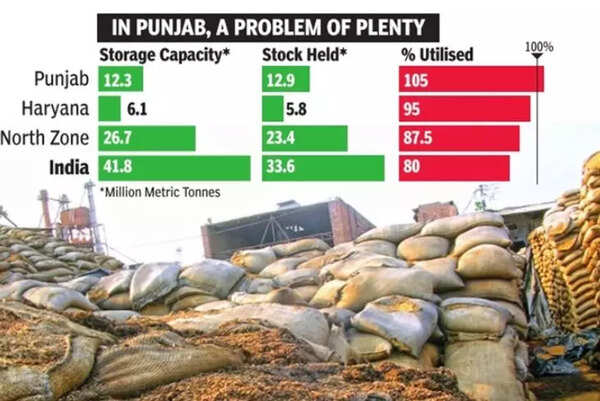Scientific storage must to reduce grain loss -Courtesy TOI 16.7.22
NEW DELHI: Punjab is a small state that makes an oversize contribution to India’s food security. With just 2% of India’s land area under agriculture, it contributes nearly one-fourth of paddy and a third of wheat to the national pool, outperforming much bigger states. Yet, a fairly large percentage of Punjab’s grain output is lost before it reaches your table. Some of it is due to natural calamities, but the rest is largely avoidable loss.
Studies have shown that the loss of grain during harvesting, threshing, transportation and storage is quite significant. While an earlier estimate pegged this loss at 9. 3%, the Indian Grain Storage Management and Research Institute (IGSMRI) says postharvest losses amount to nearly 10%.

Among all the factors that lead to food waste, there’s one that can be easily fixed with investment – food storage. In a state like Punjab, the available storage space can’t keep up with the record production year after year, but more worrying is the shortage of storage facilities developed scientifically. Every year, thousands of tonnes of grain stored at the plinth level gets damaged.
While it is a huge monetary loss, it has some hidden environmental costs too. All the diesel used in tractors, pumps and harvesters to grow and harvest the lost grain at great environmental cost also goes waste. Fertilisers and pesticides pollute soil and water, so wasted grain just raises the environmental cost without any benefit.
That’s why developing scientific storage facilities is key to reducing resource use, which is the third ‘R’ of circularity.
Over the years Punjab has also come to be blamed for north India’s air pollution at the onset of winter. The problem is related to the state’s role as the ‘granary of India’. Since the Green Revolution it has become entrenched in the wheat-paddy cycle. Its farmers don’t have enough time between the paddy and wheat seasons, so they burn paddy stubble to get their fields ready for the next crop.
But this approach does not gel with the fourth and fifth R’s of circularity – reuse and recycle. The vast amounts of crop residue that is burnt in Punjab’s fields every year – 20 million tonnes out of a total residue of 51 million tonnes – is biomass that can increase soil fertility as compost, reducing the need for fertilisers.
Some on-site and off-site processes for crop residue management have been put in place but they are yet to show results. Punjab Remote Sensing Centre recorded alarming levels of crop residue burning at the end of the past three paddy seasons.
The Punjab government has put in place several plans to reduce crop residue burning. These include making residue management machinery available and providing subsidy for its purchase. It is also preparing more scientific storage space. These measures should bear fruit in the coming years.
Share to Twitter
FOLLOW US ON SOCIAL MEDIA
FACEBOOKTWITTERINSTAGRAMKOO APP


Comments